Sterile Processing Technician
Chiropractic Assistant vs Sterile Processing Technician

Want personalized recommendations?
Let's match you to the right program

Key Points:
- Chiropractic Assistants support chiropractors; Sterile Processing Technicians prepare and sterilize medical equipment.
- Chiropractic Assistants typically earn less than Sterile Processing Technicians.
- Sterile Processing Technician jobs are more widely available than Chiropractic Assistant roles.
- Chiropractic Assistants can often train on the job, while Sterile Processing Technicians require formal training.
- Chiropractic Assistant training is generally less costly and shorter than Sterile Processing Technician training.
Healthcare is a rapidly growing field, and there is a demand for skilled professionals. Chiropractic Assistants and Sterile Processing Technicians play important roles in the healthcare industry, but their responsibilities and job requirements differ. Understanding the differences between these two careers can help individuals make an informed decision about which path to pursue.
Article continues after recommendations
Recommended for you
What is a Chiropractic Assistant and Sterile Processing Technician?
Chiropractic Assistant
A Chiropractic Assistant is a healthcare professional who works alongside chiropractors to provide administrative and clinical support. They are responsible for managing the front desk, scheduling appointments, maintaining patient records, and assisting with patient care. Chiropractic Assistants may also perform basic clinical tasks such as taking vital signs, preparing patients for treatments, and assisting with therapies.
Sterile Processing Technician
A Sterile Processing Technician, on the other hand, is responsible for ensuring that all medical equipment and instruments are properly cleaned, sterilized, and stored. They work in hospitals, surgical centers, and other healthcare facilities to ensure that all instruments are safe and ready for use. Sterile Processing Technicians are responsible for following strict protocols and guidelines to prevent the spread of infection.
Difference between a Chiropractic Assistant and Sterile Processing Technician
While both Chiropractic Assistants and Sterile Processing Technicians work in healthcare settings, there are some key differences between the two careers. These include:
-
Job Duties: Chiropractic Assistants primarily focus on providing administrative and clinical support to chiropractors, while Sterile Processing Technicians are responsible for ensuring the cleanliness and sterilization of medical equipment and instruments.
-
Patient Interaction: Chiropractic Assistants have direct patient interaction as they assist with patient care, take vital signs, and prepare patients for treatments. Sterile Processing Technicians, on the other hand, have limited patient interaction and primarily work behind the scenes to ensure the safety of medical equipment.
-
Work Environment: Chiropractic Assistants typically work in chiropractic offices or clinics, while Sterile Processing Technicians work in hospitals, surgical centers, and other healthcare facilities.
Chiropractic Assistant vs Sterile Processing Technician: Job Description
Chiropractic Assistant
As mentioned earlier, the primary role of a Chiropractic Assistant is to provide administrative and clinical support to chiropractors. Some of the key job responsibilities of a Chiropractic Assistant include:
- Managing the front desk, scheduling appointments, and greeting patients
- Maintaining patient records and ensuring confidentiality
- Assisting with patient care, including taking vital signs and preparing patients for treatments
- Performing basic clinical tasks such as applying therapies and assisting with exercises
- Providing education to patients on chiropractic care and wellness practices
Sterile Processing Technician
Sterile Processing Technicians have a different set of job responsibilities. Their main focus is on ensuring that all medical equipment and instruments are properly cleaned, sterilized, and stored. Some of the key job responsibilities of a Sterile Processing Technician include:
- Disassembling, cleaning, and sterilizing medical equipment and instruments
- Inspecting instruments for damage or defects and reporting any issues
- Assembling instrument trays and ensuring they are properly sterilized
- Operating sterilization equipment and following strict protocols and guidelines
- Keeping accurate records of sterilization processes and maintaining inventory of supplies
Chiropractic Assistant vs Sterile Processing Technician: Education and Training
Get courses selected just for you
Try our powerful search engine
Article continues after recommendations
More recommendations for you
Chiropractic Assistant
The educational requirements for becoming a Chiropractic Assistant can vary. Some employers may require a high school diploma or equivalent, while others may prefer candidates with post-secondary education or certification. Chiropractic Assistant programs are available at vocational schools and community colleges and typically take around one year to complete. These programs cover topics such as medical terminology, anatomy and physiology, chiropractic principles, and administrative skills.
Sterile Processing Technician
To become a Sterile Processing Technician, individuals typically need a high school diploma or equivalent. Many employers also require completion of a Sterile Processing Technician program, which can be found at vocational schools and community colleges. These programs can range from a few months to one year in length and cover topics such as infection control, sterilization techniques, anatomy and physiology, and medical terminology. Some states may also require Sterile Processing Technicians to obtain certification.
Chiropractic Assistant vs Sterile Processing Technician: Career Outlook and Salary
Chiropractic Assistant
According to the Bureau of Labor Statistics, the employment of Chiropractic Assistants is projected to grow 10 percent from 2019 to 2029, which is faster than the average for all occupations. The demand for chiropractic services is expected to increase as more people seek alternative healthcare options. The median annual wage for Chiropractic Assistants was $34,800 in May 2020.
Sterile Processing Technician
The career outlook for Sterile Processing Technicians is also positive. The Bureau of Labor Statistics projects a 7 percent growth in employment from 2019 to 2029. As healthcare facilities continue to emphasize infection control, the demand for Sterile Processing Technicians is expected to increase. The median annual wage for Sterile Processing Technicians was $38,740 in May 2020.
Final Thoughts
Both Chiropractic Assistants and Sterile Processing Technicians play important roles in the healthcare industry. While Chiropractic Assistants focus on providing administrative and clinical support to chiropractors, Sterile Processing Technicians ensure the cleanliness and sterilization of medical equipment and instruments. The educational requirements for both careers vary, with Chiropractic Assistants typically requiring a shorter period of training. The career outlook for both Chiropractic Assistants and Sterile Processing Technicians is positive, with projected job growth and competitive salaries. Individuals interested in pursuing a career in healthcare should carefully consider their interests and skills before choosing between these two professions.
Dreambound strategically offers its educational programs in diverse locations. To gain a thorough insight into the exciting opportunities within these two vocations, we encourage you to explore more detailed information by visiting:

Sunshine is a member of the School Growth team at Dreambound, where she assists students and schools with their billing and onboarding needs. She is a licensed mechanical engineer. Outside of work, she enjoys road trips with her family, discovering cozy cafes, and exploring her love for art.



